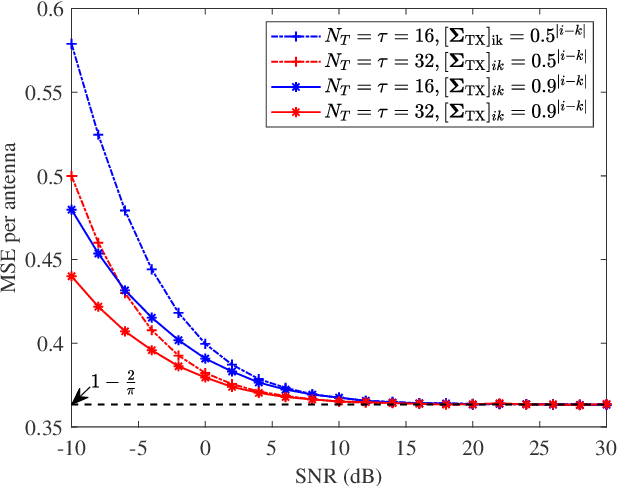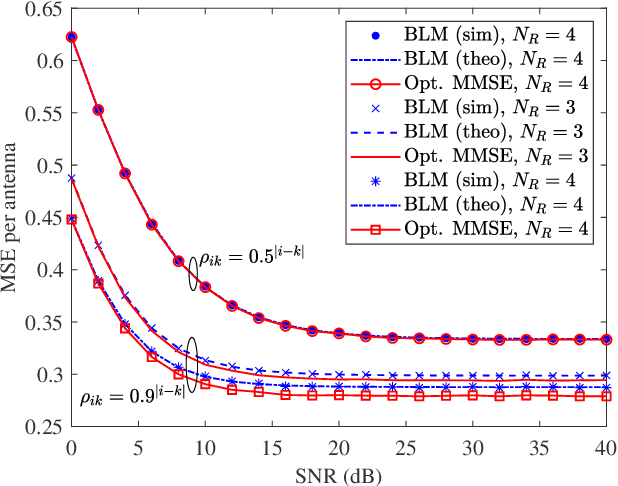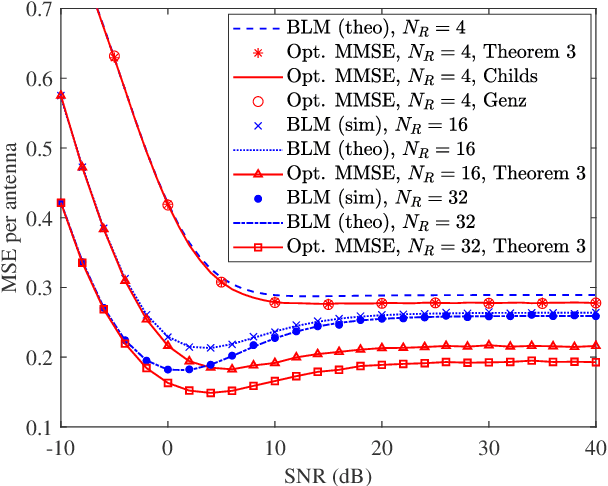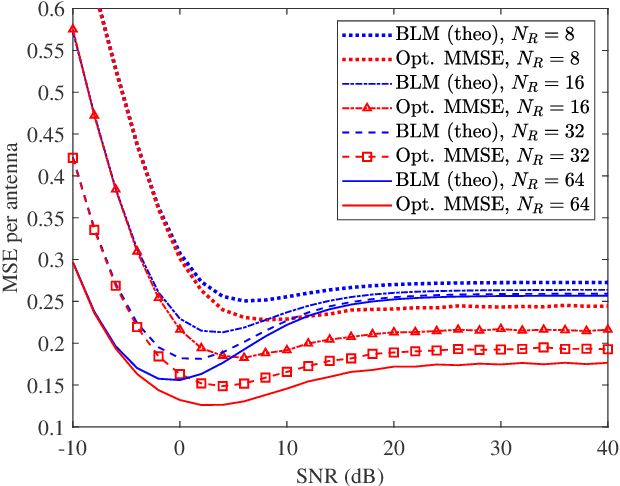Antti Tölli
SEP Analysis of 1-Bit Quantized SIMO Systems with QPSK over Fading Channels
Oct 02, 2025Abstract:The average symbol error probability (SEP) of a 1-bit quantized single-input multiple-output (SIMO) system is analyzed under Rayleigh fading channels and quadrature phase-shift keying (QPSK) modulation. Previous studies have partially characterized the diversity gain for selection combining (SC). In this paper, leveraging a novel analytical method, an exact analytical SEP expression is derived for a 1-bit quantized SIMO system employing QPSK modulation at the transmitter and maximum ratio combining (MRC) at the receiver. The corresponding diversity and coding gains of a SIMO-MRC system are also determined. Furthermore, the diversity and coding gains of a 1-bit quantized SIMO-SC system are quantified for an arbitrary number of receive antennas, thereby extending and complementing prior results.
Massive MIMO with 1-Bit DACs: Data Detection for Quantized Linear Precoding with Dithering
Jun 05, 2025Abstract:To leverage high-frequency bands in 6G wireless systems and beyond, employing massive multiple-input multipleoutput (MIMO) arrays at the transmitter and/or receiver side is crucial. To mitigate the power consumption and hardware complexity across massive frequency bands and antenna arrays, a sacrifice in the resolution of the data converters will be inevitable. In this paper, we consider a point-to-point massive MIMO system with 1-bit digital-to-analog converters at the transmitter, where the linearly precoded signal is supplemented with dithering before the 1-bit quantization. For this system, we propose a new maximumlikelihood (ML) data detection method at the receiver by deriving the mean and covariance matrix of the received signal, where symbol-dependent linear minimum mean squared error estimation is utilized to efficiently linearize the transmitted signal. Numerical results show that the proposed ML method can provide gains of more than two orders of magnitude in terms of symbol error rate over conventional data detection based on soft estimation.
Near-Field MIMO Channel Acquisition: Geometry-Aided Feedback and Transmission Design
May 07, 2025Abstract:Near-field (NF) line-of-sight (LoS) MIMO systems enable efficient channel state information (CSI) acquisition and precoding by exploiting known antenna geometries at both the base station (BS) and user equipment (UE). This paper introduces a compact parameterization of the NF LoS MIMO channel using two angles of departure (AoDs) and a BS-UE relative rotation angle. The inclusion of the second AoD removes the need for fine-grained distance grids imposed by conventional NF channel parametrization. To address the user-specific uplink pilot overhead in multiuser NF CSI acquisition, we propose a scheme that uses a fixed, UE-independent set of downlink pilots transmitted from a carefully selected subset of BS antennas. In dominant LoS conditions, as few as four pilots suffice, with Cram\'er-Rao bound (CRB) analysis confirming that increased antenna spacing improves estimation accuracy. Each UE estimates and quantizes its angular parameters and feeds them back to the BS for geometry-based CSI reconstruction, eliminating the need for full channel feedback. To enhance robustness against noise, quantization errors, and non-line-of-sight (NLoS) components, we introduce a two-stage precoding method. The initial precoding is computed from estimated LoS CSI and refined through bidirectional over-the-air (OTA) training. Furthermore, a two-step stream allocation strategy reduces pilot and computational overhead. Simulations demonstrate that the proposed approach achieves high data rates with significantly fewer OTA iterations, approaching the performance of perfect CSI.
Data-Aided Regularization of Direct-Estimate Combiner in Distributed MIMO Systems
Jan 21, 2025Abstract:This paper explores the data-aided regularization of the direct-estimate combiner in the uplink of a distributed multiple-input multiple-output system. The network-wide combiner can be computed directly from the pilot signal received at each access point, eliminating the need for explicit channel estimation. However, the sample covariance matrix of the received pilot signal that is used in its computation may significantly deviate from the actual covariance matrix when the number of pilot symbols is limited. To address this, we apply a regularization to the sample covariance matrix using a shrinkage coefficient based on the received data signal. Initially, the shrinkage coefficient is determined by minimizing the difference between the sample covariance matrices obtained from the received pilot and data signals. Given the limitations of this approach in interference-limited scenarios, the shrinkage coefficient is iteratively optimized using the sample mean squared error of the hard-decision symbols, which is more closely related to the actual system's performance, e.g., the symbol error rate (SER). Numerical results demonstrate that the proposed regularization of the direct-estimate combiner significantly enhances the SER, particularly when the number of pilot symbols is limited.
Achievable DoF Bounds for Cache-Aided Asymmetric MIMO Communications
Jan 18, 2025Abstract:Integrating coded caching (CC) into multiple-input multiple-output (MIMO) communications can significantly enhance the achievable degrees of freedom (DoF) in wireless networks. This paper investigates a practical cache-aided asymmetric MIMO configuration with cache ratio $\gamma$, where a server equipped with $L$ transmit antennas communicates with $K$ users, each having $G_k$ receive antennas. We propose three content-aware MIMO-CC strategies: the \emph{min-G} scheme, which treats the system as symmetric by assuming all users have the same number of antennas, equal to the smallest among them; the \emph{Grouping} scheme, which maximizes spatial multiplexing gain separately within each user subset at the cost of some global caching gain; and the \emph{Phantom} scheme, which dynamically redistributes spatial resources using virtual or "phantom" antenna users, bridging the performance gains of the min-G and Grouping schemes. These strategies jointly optimize the number of users, $\Omega$, and the parallel streams decoded by each user, $\beta_k$, ensuring linear decodability for all target users. Analytical and numerical results confirm that the proposed schemes achieve significant DoF improvements across various system configurations, demonstrating the potential of content-aware MIMO-CC strategies for enhancing wireless network performance.
Uplink Transmit Power Optimization for Distributed Massive MIMO Systems with 1-Bit ADCs
Jul 22, 2024Abstract:This paper addresses the problem of uplink transmit power optimization in distributed massive multiple-input multiple-output systems, where remote radio heads (RRHs) are equipped with 1-bit analog-to-digital converters (ADCs). First, in a scenario where a single RRH serves a single user equipment (UE), the signal-to-noise-and-distortion ratio (SNDR) is shown to be a non-monotonic and unimodal function of the UE transmit power due to the quantization distortion (QD). Upon the introduction of multiple RRHs, adding properly tuned dithering at each RRH is shown to render the SNDR at the output of the joint receiver unimodal. In a scenario with multiple RRHs and UEs, considering the non-monotonic nature of the signal-to-interference-plus-noise-and-distortion ratio (SINDR), both the UE transmit powers and the RRH dithering levels are jointly optimized subject to the min-power and max-min-SINDR criteria, while employing Bussgang-based maximum ratio combining (BMRC) and minimum mean squared error (BMMSE) receivers. To this end, gradient and block coordinate descent methods are introduced to tune the UE transmit powers, whereas a line search coupled with gradient updates is used to adjust the RRH dithering levels. Numerical results demonstrate that jointly optimizing the UE transmit power and the RRH dithering levels can significantly enhance the system performance, thus facilitating joint reception from multiple RRHs across a range of scenarios. Comparing the BMMSE and BMRC receivers, the former offers a better interference and QD alleviation while the latter has a lower computational complexity.
Enhanced Achievable DoF Bounds for Cache-Aided MIMO Communication Systems
Jul 22, 2024Abstract:Integrating coded caching (CC) into multiple-input multiple-output (MIMO) communications may significantly enhance the achievable degrees of freedom (DoF) of the wireless networks. In this paper, we consider a cache-aided MIMO configuration with a CC gain $t$, where a server with $L$ Tx antennas communicates with $K$ users, each with $G$ Rx antennas. In the proposed content-aware MIMO strategy, we carefully adjust the number of users $\Omega$ and the number of parallel streams decoded by each user $\beta$ served in each transmission to maximize the DoF. As a result, we achieve a DoF of ${\max_{\beta, \Omega }}{\Omega \beta}$, where ${\beta \le \mathrm{min}\big(G,\frac{L \binom{\Omega-1}{t}}{1 + (\Omega - t-1)\binom{\Omega-1}{t}}\big)}$. To prove the achievability of the proposed DoF bound, we provide a novel transmission strategy based on the simultaneous unicasting of multiple data streams. In this strategy, the missing data packets are scheduled such that the number of parallel streams per transmission is maximized while the decodability of all useful terms by each target user is guaranteed. Numerical simulations validate the findings, confirming the enhanced DoF and improved performance of the proposed design.
Optimality of the Bussgang Linear MMSE Channel Estimator for MIMO Systems with 1-Bit ADCs
Jul 18, 2024

Abstract:In this paper, we study the optimality of the Bussgang linear minimum mean squared error (BLMMSE) channel estimator for multiple-input multiple-output systems with 1-bit analog-to-digital converters. We compare the BLMMSE with the optimal minimum mean squared error (MMSE) channel estimator, which is generally non-linear, and we develop a novel framework based on the orthant probability of a multivariate normal distribution to compute the MMSE channel estimate. Then, we analyze the equivalence of the MMSE and BLMMSE channel estimators under specific assumptions on the channel correlation or pilot symbols. Interestingly, the BLMMSE channel estimator turns out to be optimal in several specific cases. Our study culminates with the presentation of a necessary and sufficient condition for the BLMMSE channel estimator to be optimal.
On the Optimal MMSE Channel Estimation for One-Bit Quantized MIMO Systems
Apr 08, 2024



Abstract:This paper focuses on the minimum mean squared error (MMSE) channel estimator for multiple-input multiple-output (MIMO) systems with one-bit quantization at the receiver side. Despite its optimality and significance in estimation theory, the MMSE channel estimator has not been fully investigated in this context due to its general non-linearity and computational complexity. Instead, the typically suboptimal Bussgang linear MMSE (BLMMSE) estimator has been widely adopted. In this work, we develop a new framework to compute the MMSE channel estimator that hinges on computation of the orthant probability of the multivariate normal distribution. Based on this framework, we determine a necessary and sufficient condition for the BLMMSE channel estimator to be optimal and equivalent to the MMSE estimator. Under the assumption of specific channel correlation or pilot symbols, we further utilize the framework to derive analytical expressions for the MMSE channel estimator that are particularly convenient for computation when certain system dimensions become large, thereby enabling a comparison between the BLMMSE and MMSE channel estimators in these cases.
Combined DL-UL Distributed Beamforming Design for Cell-Free Massive MIMO
Apr 04, 2024



Abstract:We consider a cell-free massive multiple-input multiple-output system with multi-antenna access points (APs) and user equipments (UEs), where the UEs can be served in both the downlink (DL) and uplink (UL) within a resource block. We tackle the combined optimization of the DL precoders and combiners at the APs and DL UEs, respectively, together with the UL combiners and precoders at the APs and UL UEs, respectively. To this end, we propose distributed beamforming designs enabled by iterative bi-directional training (IBT) and based on the minimum mean squared error criterion. To reduce the IBT overhead and thus enhance the effective DL and UL rates, we carry out the distributed beamforming design by assuming that all the UEs are served solely in the DL and then utilize the obtained beamformers for the DL and UL data transmissions after proper scaling. Numerical results show the superiority of the proposed combined DL-UL distributed beamforming design over separate DL and UL designs, especially with short resource blocks.
 Add to Chrome
Add to Chrome Add to Firefox
Add to Firefox Add to Edge
Add to Edge